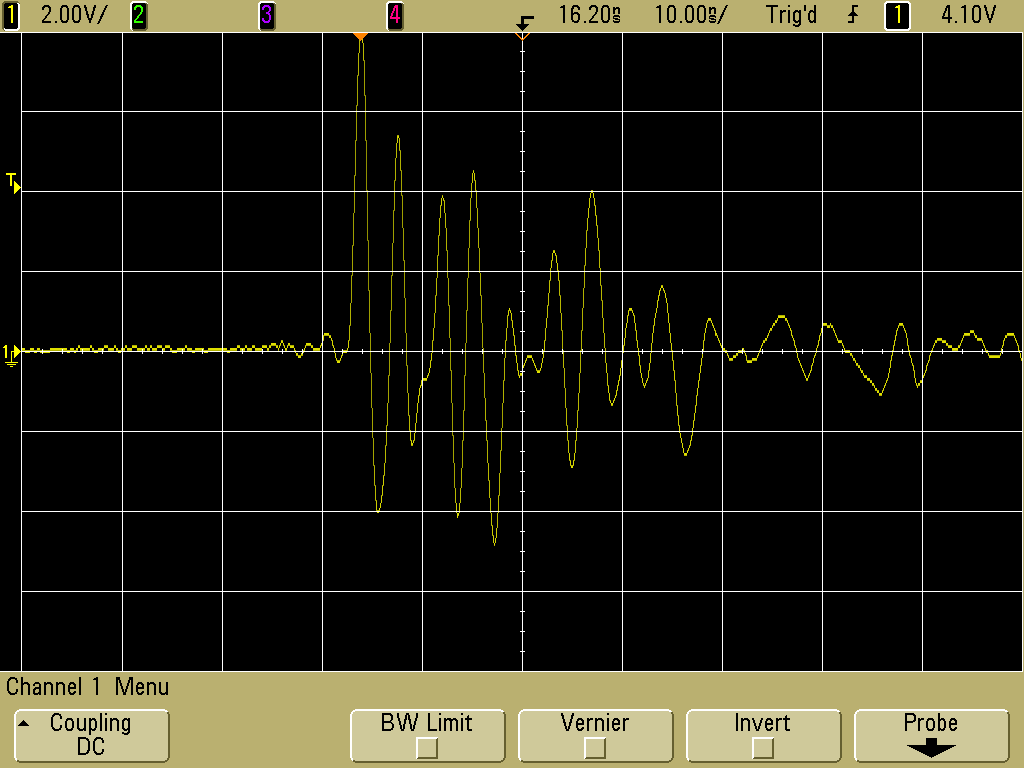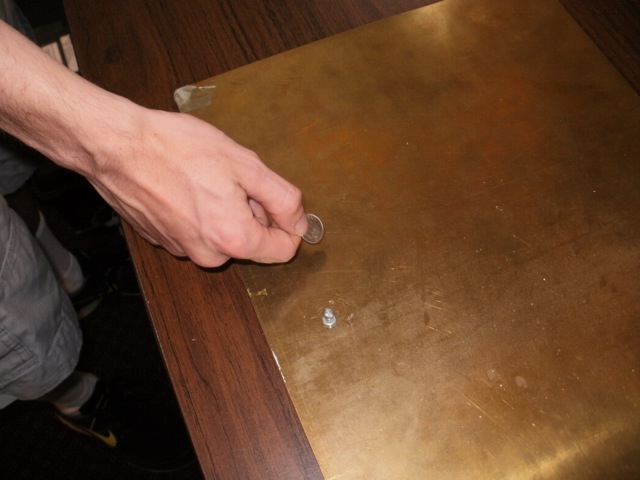Most system level ESD test standards,
like IEC61000-4-2, model an ESD event from a human hand holding a piece
of metal, such as a tool. This is called the
Human
Metal
Model, HMM. The
April 2013 Technical Tidbit
showed that a piece of metal in a human hand significantly intensifies
an ESD event. But, how does the intensity of such an ESD event, and the
resulting likelihood of system upset, depend on the size of the metal
object?
Figure 1 shows the test setup used to generate data for this Technical
Tidbit. A metal plate is used as the discharge target. After each
discharge, the plate is discharged to AC mains safety ground before the
next discharge. Next to the plate is an
Agilent 1163A, 1 GHz 500 Ohm resistive passive probe shorted by its ground lead and connected to an
Agilent
DSO5054A
oscilloscope. The shorted probe acts like a magnetic loop and picks up
the EMI radiation from the ESD event to the plate. The displayed
waveform on the scope is a measure of the intensity of the ESD event
and its ability to disrupt nearby electronic equipment.
Figure 2 shows a discharge applied by a long metal pointer. The person
is charged up by rubbing a foot on the carpet and then lifting it.
Developing a static charge this way in Boulder City, NV, my office and
lab location, is pretty easy because of the dry desert environment.

Figure 2. Human Metal ESD From a Long Metal Pointer
I took a number of discharges this way and the waveform shown in Figure
3 was typical. Note that peak voltage induced in the probe-ground lead
loop was over 8 Volts peak, the top of the screen! No wonder that ESD can disrupt equipment
operation.
Figure 3. Voltage Induced in 1163A Shorted Scope Probe by HMM ESD - Long Metal Pointer
(Vertical Scale = 2 V/div, Horizontal Scale = 10 ns/div)
Figure 4 shows the same experiment but this time the metal pointer was collapsed to its smallest length, about 6 inches, 15 cm.
Charge was developed the same way and a typical resulting waveform is
shown in Figure 5.
Figure 4. Human Body ESD From a Collapsed Metal Pointer
Note that the peak voltage recorded is still well over 8 Volts in
Figure 5! The difference is that the low frequency component of the
ringing is not present because of the smaller size of the collapsed
pointer compared to the extended pointer.

Figure 5. Voltage Induced in 1163A Shorted Scope Probe by HBM ESD - Collapsed Metal Pointer
(Vertical Scale = 2 V/div, Horizontal Scale = 10 ns/div)
Figure 6 shows the same experiment, but this time a small metal coin was used, a US dime.
Charge was developed the same way and a typical resulting waveform is
shown in Figure 7.

Figure 6. Human Body ESD from a Small Coin
 Figure 7.
Figure 7. Voltage Induced in 1163A Shorted Scope Probe by HBM ESD - Coin
(Vertical Scale = 2 V/div, Horizontal Scale = 10 ns/div)
Although the peak voltage is lower in Figure 8, almost 6 volts,
is is not smaller in proportion to the size of the metal. The coin is
maybe 1/10 the size of the collapsed probe and maybe 100 the size of
the extended pointer, but the peak voltage induced in the probe is only a little smaller. The
April 2013 Technical Tidbit, shows that a
discharge directly from the skin is much, much smaller than from a
piece of metal. Thus, any size piece of metal significantly increases
the intensity of a static discharge from a human hand!
Summary: There is
a large increase in the intensity of an ESD event from a human
hand when a piece of metal is added. The
measured intensity of the radiated EMI from the ESD event shows that once metal
is added to the human hand, the increased intensity of the event is not
a significant function of the size of the piece of metal.
Acknowledgment: Thanks to
David Smith, my youngest son, who held the metal pieces and generated
the ESD events. He is currently studying Computer Science in college.
An article on this website related to this topic is:
- April 2013, Human Metal vs. Human Body ESD
(Metal in a Human Hand significantly increases ESD intensity)
Equipment used in this Technical Tidbit:
- Agilent 1163A, 1 GHz 500 Ohm resistive passive probe
- Agilent
DSO5054A








